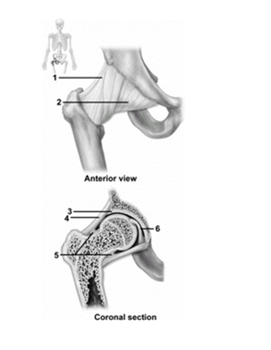B) False
Correct Answer

verified
True
Correct Answer
verified
Multiple Choice
Which of the following describes a meniscus
A) Attach one bone to another at a joint
B) Fibrous cartilage pads
C) Flat,fluid-filled sacs
D) Found only at the temporomandibular joint
E) Attach muscles to bones
G) A) and D)
Correct Answer

verified
Correct Answer
verified
Multiple Choice
Which is not correct regarding articulations
A) An articulation is a joint between a bone and another bone,cartilage,or tooth.
B) All articulations contain some type of cartilage.
C) Arthrology is the scientific study of articulations.
D) Articulations can range in motion from freely mobile to immobile.
E) There are three structural categories of articulations.
G) A) and B)
Correct Answer

verified
Correct Answer
verified
Multiple Choice
When compared to the shoulder,the hip joint has
A) a deeper bony socket and stronger supporting ligaments.
B) a deeper bony socket but weaker supporting ligaments.
C) a shallower bony socket and weaker supporting ligaments.
D) a shallower bony socket but stronger supporting ligaments.
F) A) and B)
Correct Answer

verified
Correct Answer
verified
Multiple Choice
The glenohumeral ligaments are
A) strong and distinct.
B) weak and indistinct.
D) undefined
Correct Answer

verified
B
Correct Answer
verified
Multiple Choice
 -These figures show the coxal joint.What structure does number 6 indicate
-These figures show the coxal joint.What structure does number 6 indicate
A) Ischiofemoral ligament
B) Iliofemoral ligament
C) Articular capsule
D) Ligament of head of femur
E) Acetabular ligament
G) B) and D)
Correct Answer

verified
D
Correct Answer
verified
Short Answer
In a gomphosis,a tooth is held in place by fibrous structures known as __________ membranes.
Correct Answer

verified
Correct Answer
verified
Multiple Choice
Which knee ligament is most crucial for preventing hyperadduction
A) Tibial collateral ligament
B) Fibular collateral ligament
C) Patellar ligament
D) Anterior cruciate ligament
E) Medial meniscus
G) A) and E)
Correct Answer

verified
Correct Answer
verified
Multiple Choice
In addition to the joint between the tibia and the femur,the knee contains a joint between the
A) fibula and the femur.
B) patella and the fibula.
C) patella and the femur.
D) patella and the tibia.
F) A) and C)
Correct Answer

verified
Correct Answer
verified
Short Answer
The lining of an articular capsule is called the ___________ membrane.
Correct Answer

verified
Correct Answer
verified
Short Answer
A _________ is an elongated,rigid object that can be used to alter the distance of movement produced by a force.
Correct Answer

verified
Correct Answer
verified
Multiple Choice
A synarthrotic joint would have
A) high mobility and high stability.
B) high mobility and low stability.
C) low mobility and low stability.
D) low mobility and high stability.
F) C) and D)
Correct Answer

verified
Correct Answer
verified
True/False
Sutures permit skull growth during childhood.
B) False
Correct Answer

verified
Correct Answer
verified
Multiple Choice
In general,the movements demonstrated at plane joints between the carpals are
A) rotations.
B) gliding movements.
C) flexions and extensions.
D) circumductions.
E) pivots.
G) B) and D)
Correct Answer

verified
Correct Answer
verified
Multiple Choice
Our calf muscles contract to cause plantar flexion,resembling the lever system of a wheelbarrow.Therefore,it is a _______ -class lever.
A) first
B) second
C) third
E) All of the above
Correct Answer

verified
Correct Answer
verified
Short Answer
A slightly mobile joint is referred to as a(n)_________.
Correct Answer

verified
Correct Answer
verified
Multiple Choice
What is the function of the cruciate ligaments in the knee joint
A) Hold the patella in place on the femur
B) Hold the patella in place on the tibia
C) Limit the movement of the femur on the tibia
D) Limit the movement of the fibula on the femur
E) Limit the movement of the fibula on the tibia
G) A) and D)
Correct Answer

verified
Correct Answer
verified
True/False
A tendon sheath is a fat pad that fills the spaces that form when bones move.
B) False
Correct Answer

verified
Correct Answer
verified
Multiple Choice
The movement that occurs when the trunk of the body moves in a coronal plane laterally away from the body is
A) adduction.
B) hyperextension.
C) eversion
D) lateral flexion.
E) gliding.
G) None of the above
Correct Answer

verified
Correct Answer
verified
Multiple Choice
Which is not true regarding ligaments
A) Intracapsular ligaments are within the articular capsule.
B) Ligaments are composed of dense regular connective tissue.
C) Extrinsic ligaments are physically separate from the articular capsule.
D) Intrinsic ligaments are thickenings of the articular cartilage.
E) Extracapsular ligaments are outside the articular capsule.
G) A) and C)
Correct Answer

verified
Correct Answer
verified
Showing 1 - 20 of 122
Related Exams